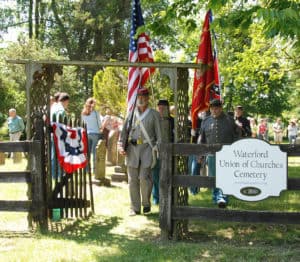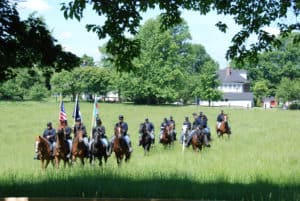Past Activities
Sesquicentennial Event
May 21,2011
Excerpted from Leesburg Today article by Margarete Morton
Saturday was a day of immersion in Civil War history for scores of people who spent the day in Waterford enjoying sunny weather while reflecting on the impacts of the conflict on north Loudoun.
This week 150 years ago, Loudoun men, led by Leesburg's John Janney who was president of the Virginia Secession Convention, voted overwhelmingly to break from the United States.
The focus of the Waterford events was to commemorate the Quaker village's strongly Unionist role during the war, which, along with that of the adjacent German heritage village of Lovettsville to the north-was unlike the rest of the county or Virginia as a whole.
The day began with two historic sign dedications.
The first, a roadside marker near the John Wesley Community Church, highlighted the activities of the Independent Loudoun Rangers. The Rangers formed the only cavalry unit raised in Virginia to fight for the North during the war, and Waterford was the home of its founder Capt Samuel C. Means, operator of a gristmill in town, who lived behind the church.
Waterford historian Taylor Chamberlin described Mean's mixed sympathies and loyalties on the eve of war as he contemplated the secession vote. In the end, Means joined 220 other Waterfordians to reject secession. Despite a similar outcome in Lovettsville, the county as a whole opted for secession by a vote of almost two to one.
Following the dedication Saturday, the group was led by cavalry re-enactors up Main Street through the village to the site of the second dedication, for a Civil War Trails sign that explains the village's role as a "Unionist Stronghold" during the war. The sign in on the grounds of the Waterford Baptist Church, a building that was damaged when Loudoun's Confederate cavalry group-the 35th Battalion of the Virginia Cavalry, the storied White's Comanches led by Lt. Col. Elijah V. White-raided Mean's Rangers nearby.
The cemetery has received a major clean up over the past few years as its trustees, under the chairmanship of Paul Rose, have undertaken a program of righting, repairing and cleaning fallen or broken headstones, trimming bushes, and removing dead trees, while keeping the cemetery mowed and tidy, greatly aided by history students from Loudoun Valley High School over the past two summers. The students helped clean many of the veterans' stones before the event.
The joint color guard-carrying the colors of the Union and the Confederacy-was led by Capt. Michael Paquette, Department of the Chesapeake, Sons of Union Veterans of the Civil War; and John A. Ward, Jr. Commander, Clinton Hatcher Camp, Sons of Confederate Veterans.
Wreaths were laid at two graves, one from each side, chosen to represent the divided loyalties of the area during the war, but which were reunited in normal civilian life after the conflict.
During a brief comment before the service, Rose said the cemetery contains 24 Civil War known veterans, each of whose graves were marked Saturday with a peony. Seventeen of the graves were Union, the other six Confederate. Thirteen of the Union dead were from the Loudoun Rangers, while four of the Confederates were from White's 35th Battalion.
The colorful event included 17 cavalry re-enactors from both sides, who clearly enjoyed retelling the events from their perspective.


